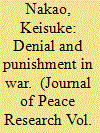| Srl | Item |
| 1 |
ID:
184198


|
|
|
|
|
| Summary/Abstract |
Formal models of war termination have been developed along two major approaches: in one, war is interpreted as a series of battles, where nations exchange denials that aim to destroy enemy forces; in the other, war is illustrated as a process of bargaining with mutual punishments that inflict costs on opponents. By integrating these two approaches, I build a dynamic model of war, where two nations choose between military force and civilian value as the targets of their attacks in every battle. The war proceeds along one of the following three paths in equilibrium. First, either nation immediately gives in to the other’s threat of punishment such as nuclear strikes. Second, both the nations continue to conduct counterforce denial campaigns to weaken each other until either side is fully disarmed (i.e. all-out war). Third, after significant military imbalance is generated by the exchange of denials in an early battle, the winner of the battle switches to a countervalue punishment campaign, to which the loser responds by capitulation (i.e. limited war). My equilibrium analyses suggest that while denials largely determine a war’s outcome, punishments can influence its duration. Unlike existing models, mine illuminates the two-way causal relationship, where past battle outcomes can influence the choice of military strategy, whereas military strategies also shape how the war will further evolve.
|
|
|
|
|
|
|
|
|
|
|
|
|
|
|
|
| 2 |
ID:
181031


|
|
|
|
|
| Summary/Abstract |
Little is known about how air strikes influence insurgent behavior toward civilians. This study provides evidence that air strikes against the Islamic State of Iraq and Syria (ISIS) by counterinsurgency forces were a contributing factor in its civilian victimization. I theorize that air strikes expanded the distribution of insurgent fatalities to include higher-echelon membership and, at the same time, imposed psychological impairments on its fighters. As a consequence, these changes relaxed restraints on civilian abuse at the organizational and individual levels. This theory is informed by interviews of ISIS defectors and translations of ISIS documents and tested through a statistical analysis of granular-level data on air strikes and one-sided violence during ISIS’s insurgency. These findings contribute to our knowledge of insurgent behavior and provide important policy implications in the use of air strikes as a counterinsurgency (COIN) tool.
|
|
|
|
|
|
|
|
|
|
|
|
|
|
|
|